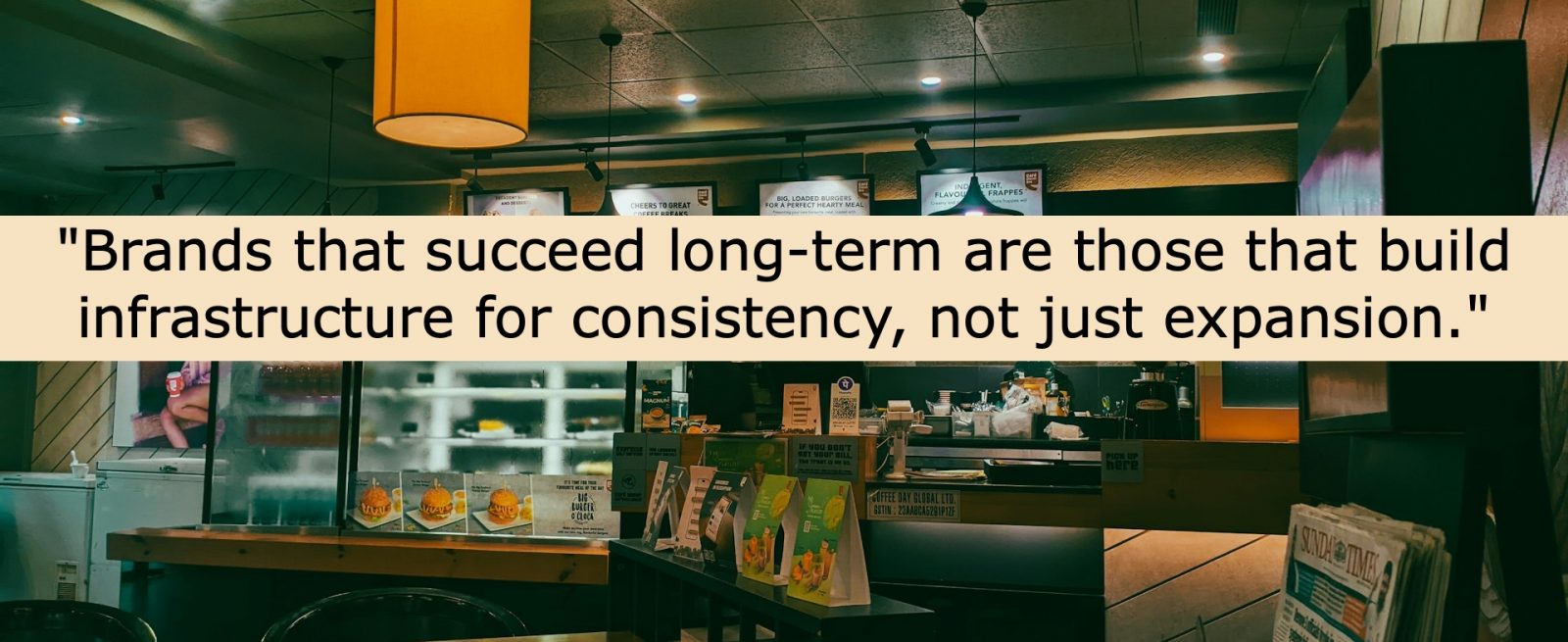Scaling Consistency in Multi-Location Brands: The Power of Digitized SOPs and Training
6 Min Read By Rafa Liñán
What happens to consistency when your brand grows faster than your systems can keep up with?
A food service or food retail brand launches with a clear identity, a strong set of procedures, and a commitment to quality. Things go well, and expansion comes naturally – new outlets, new hires, new cities… But, somehow, that initial clarity gets blurred.
Suddenly, the guest experience is no longer identical across locations. The quality and presentation of food starts to vary. Staff follow different hygiene protocols. The tone of service shifts in every store. And operations start to bend under the pressure of growth and scale.
It’s a common – and costly – challenge in our industries today. The root issue? My experience is that, in many cases, the problem is not the people. The problem is the system -or the lack thereof.
Brands that scale successfully aren’t just replicating physical locations. They’re replicating precision. That means having a robust framework to ensure that every team, at every store, knows exactly how to execute to brand standards – and, as importantly, it has the tools to do it.
The Challenge of Consistency at Scale
As food service brands expand, the margin for deviation widens. Training messages get easily diluted in transit between management, middle management and floor teams. Food safety steps “accidentally” skipped during the service rush. New locations falling out of step with updated procedures.
These aren't just minor hiccups – they can lead to compliance violations, serious reputational damage, and a breakdown in guest trust. Scaling operational consistency isn’t just about having rules in place – it’s about ensuring they’re followed, understood, and measurable across the board. That’s where digital SOPs and training tools are transforming the game.
Why Digitization Is a Game Changer
For decades, SOPs (Standard Operating Procedures) have been the backbone of operational consistency in foodservice: printed manuals, static checklists, laminated instructions above sinks – they've all done their job.
Until they didn’t.
The moment your business hits a certain scale and complexity, paper-based SOPs start to show their limits. They’re hard to update. Easy to ignore. Easier to misplace and damage. And notoriously difficult to monitor for compliance.
Digital SOPs, on the other hand, don’t just preserve standards – they scale them.They make procedures accessible in real time. They enable live updates across all brand locations. And they make it possible to measure, train, and reinforce with data: not just assumptions and good intentions.
Let’s see how the shift from paper binders to digital operations technology plays out in practice.
1. Constantly updated answers that guide your teams in real time
Kitchen and service staff rotate at light speed in food service and food retail businesses; it’s a reality our industries have struggled with for a long time, and a broad topic of discussion for another day. But, when questions arise – about an allergen protocol, a cleaning procedure, or how to handle a specific equipment alert – new recruits have no time to flip through a binder.
However, with digitized SOPs, the answer is always a few clicks away, whether on a tablet at the prep station or a mobile device on the floor.Real-time access empowers staff to solve problems quickly and confidently, reducing mistakes and minimizing delays. And for newer team members still learning the ropes, this kind of embedded support boosts confidence and reduces stress.
2. Updates that don’t get lost in translation
One of the biggest challenges in multi-location operations is change management. It can take weeks – or longer – for HQ updates on new policies o revised processes to trickle down to every team, especially if communication relies on printed notices or staff meetings.
With digital SOP platforms, changes go live instantly. They’re accompanied by push notifications or reminders.
And best of all, the software can track who’s viewed the new procedure and who may still need a nudge. This speed and transparency aren't just efficient – they’re essential for staying compliant and competitive in today’s regulatory and labor landscape.
3. Training that builds habits, not just awareness
Great training doesn’t just inform – it reinforces.Too often, new hires receive a whirlwind of onboarding materials in their first week, only to forget key steps under pressure. The digital training modules offered by automated platforms deliver a different approach: bite-sized, visual, repeatable learning embedded directly into day-to-day workflows.
Interactive SOPs with embedded videos, photos, and checklists make information easier to retain. Built-in audits and checkpoints ensure understanding. And because the platform knows where each employee left off, it’s easier to pick up the thread or refresh periodically.
This is especially important for food service, food retail, hotel and institutional catering teams with high turnover. A system that supports quick, standardized onboarding can make the difference between chaos and consistency.
4. Data that tells you what’s actually happening
With paper SOPs, compliance is largely assumed – or dependent on manual audits. With digital SOPs, every interaction generates data. You can see which member of your staff completed his/her training, how often they access procedures, which tasks are skipped, and where delays occur. This visibility allows management to spot patterns, intervene early, and create a culture of continuous improvement.
For instance: imagine that one of your stores consistently fails to complete a closing checklist on time. With digital SOPs, managers can review task completion data, speak with the team, and reallocate responsibilities if needed. What was once a vague feeling becomes an easy-to-solve hiccup.
5. Empowered teams, not top-town control
The goal of digitizing SOPs isn’t surveillance – it’s empowerment. When procedures are easy to access, understand, and follow, staff don’t need constant supervision to do the right thing. Team members gain confidence in their ability to meet expectations and contribute to quality outcomes.
Managers spend less time micromanaging and more time leading. In other words, digital SOPs create a culture of operational excellence, not just compliance.
Real-World Impact of Digital SOPs and Training
Let’s say your brand operates 20 locations. Obviously, each kitchen is expected to follow the same opening, prep, service, and closing routines. Procedures have been set, checklists distributed, and expectations communicated.
But things don’t always go according to plan. Reality has a way to interfere: staff turnover may have risen unexpectedly, a number of assistant managers may still be in training, and/or a new menu rollout may be straining the team’s capacity.
Then comes the news: a surprise health inspection is scheduled this week. With a paper-based system, aligning everyone on updated hygiene protocols or allergen procedures might take days – if not weeks. Reprinting manuals, sending emails, coordinating re-training… it's a time-consuming scramble.
Now imagine that same scenario with a digital SOP software in place. You update the procedure once at HQ, push it live to all locations in seconds, and send a team-wide alert. The checklist appears automatically when staff begin their shift. You can see in real time which employees have acknowledged the changes, which stores are already implementing them, and where follow-ups are needed.
When the inspector walks through the door, the team isn’t crossing fingers. They’re confident. Not because they memorized everything last night, but because they’ve been guided by the right tools every day. This kind of transformation isn’t hypothetical.
Our work with thousands of brands confirms that beyond compliance, this kind of digital transformation often leads to measurable gains:
- Fewer critical violations during inspections
- Faster onboarding and fewer training errors
- Greater team confidence and clarity
- Significant time savings for supervisors and managers
In other words, digital SOPs don’t just reduce stress – they build long-term stability. They replace last-minute catch-up with a continuous, built-in system of readiness. And when that kind of structure becomes part of your brand’s DNA, the benefits extend far beyond audits.
The Case for Digital SOPs and Training
In food service, growth is a double-edged sword. It brings opportunity – but also complexity. I believe that brands that succeed long-term are those that build infrastructure for consistency, not just expansion.
Digitized SOPs and training are part of that infrastructure. They reduce risk, increase efficiency, and give every location the tools to perform at its best.
As our industry continues to face pressures from labor shortages, regulatory demands, and evolving guest expectations, the case for digital transformation is stronger than ever. Not as a gimmick or a trend – but as a foundation for smarter, more resilient operations.


